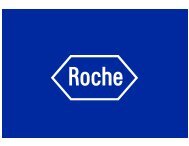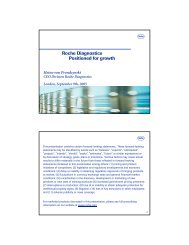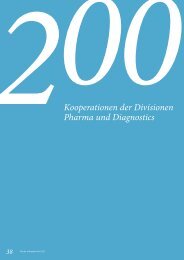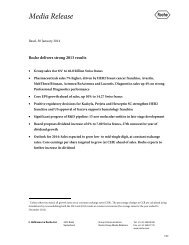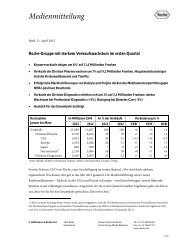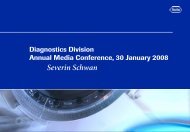Transforming the future of cancer treatment Oncology ... - Roche
Transforming the future of cancer treatment Oncology ... - Roche
Transforming the future of cancer treatment Oncology ... - Roche
Create successful ePaper yourself
Turn your PDF publications into a flip-book with our unique Google optimized e-Paper software.
Hedgehog signaling<br />
1. Rubin LL, de Sauvage FJ. Targeting <strong>the</strong> Hedgehog pathway in <strong>cancer</strong>. Nat Rev Drug Discov. 2006;5:1026-1033.<br />
2. Ingham PW, McMahon AP. Hedgehog signaling in animal development: paradigms and principles. Genes Dev.<br />
2001;15:3059-3087.<br />
3. Evangelista M, Tian H, de Sauvage FJ. The Hedgehog signaling pathway in <strong>cancer</strong>. Clin Cancer Res. 2006;12:5924-5928.<br />
4. Yauch RL, Gould SE, Scales SJ, et al. A paracrine requirement for hedgehog signalling in <strong>cancer</strong>. Nature. 2008;455:406-410.<br />
5. Scales SJ, de Sauvage FJ. Mechanisms <strong>of</strong> Hedgehog pathway activation in <strong>cancer</strong> and implications for <strong>the</strong>rapy.<br />
Trends Pharmacol Sci. 2009;30:303-312.<br />
6. Williams JA, Guicherit OM, Zaharian BI, et al. Identification <strong>of</strong> a small molecule inhibitor <strong>of</strong> <strong>the</strong> hedgehog signaling pathway:<br />
effects on basal cell carcinoma-like lesions. Proc Natl Acad Sci U S A. 2003;100:4616-4621.<br />
7. Romer JT, Kimura H, Magdaleno S, et al. Suppression <strong>of</strong> <strong>the</strong> Shh pathway using a small molecule inhibitor eliminates<br />
medulloblastoma in Ptc1 +/- p53 -/- mice. Cancer Cell. 2004;6:229-240.<br />
8. Robarge KD, Brunton SA, Castanedo GM, et al. GDC-0449—a potent inhibitor <strong>of</strong> <strong>the</strong> hedgehog pathway.<br />
Bioorg Med Chem Lett. 2009;19:5576-5581.<br />
HER signaling<br />
1. Ménard S, Tagliabue E, Campiglio M, Pupa SM. Role <strong>of</strong> HER2 gene overexpression in breast carcinoma. J Cell Physiol.<br />
2000;182:150-162.<br />
2. Sliwkowski MX. In: Harris JR, Lippman ME, Morrow M, Osborne CK, eds. Diseases <strong>of</strong> <strong>the</strong> Breast. 3rd ed. Philadelphia, PA:<br />
Lippincott Williams & Wilkins; 2004:415-426.<br />
3. Prenzel N, Fischer OM, Streit S, Hart S, Ullrich A. The epidermal growth factor receptor family as a central element for cellular<br />
signal transduction and diversification. Endocr Relat Cancer. 2001;8:11-31.<br />
4. Hynes NE, Stern DF. The biology <strong>of</strong> erbB-2/neu/HER-2 and its role in <strong>cancer</strong>. Biochim Biophys Acta. 1994;1198:165-184.<br />
5. Linggi B, Carpenter G. ErbB receptors: new insights on mechanisms and biology. Trends Cell Biol. 2006;16:649-656.<br />
6. Lewis Phillips GD, Li G, Dugger DL, et al. Targeting HER2-positive breast <strong>cancer</strong> with trastuzumab-DM1, an antibody-cytotoxic<br />
drug conjugate. Cancer Res. 2008;68:9280-9288.<br />
7. Cassady JM, Chan KK, Floss HG, Leistner E. Recent developments in <strong>the</strong> maytansinoid antitumor agents.<br />
Chem Pharm Bull (Tokyo). 2004;52:1-26.<br />
8. Parsons K, Crocker L, Leipold D, et al. Trastuzumab directed cytotoxic <strong>the</strong>rapy: efficacy against HER2-positive trastuzumabinsensitive<br />
breast <strong>cancer</strong> models and enhanced response in trastuzumab-sensitive models. Presented at: 98th American<br />
Association for Cancer Research Annual Meeting; April 14-18, 2007; Los Angeles, CA. Abstract 649.<br />
9. Adams CW, Allison DE, Flagella K, et al. Humanization <strong>of</strong> a recombinant monoclonal antibody to produce a <strong>the</strong>rapeutic HER<br />
dimerization inhibitor, pertuzumab. Cancer Immunol Immuno<strong>the</strong>r. 2006;55:717-727.<br />
10. Agus DB, Akita RW, Fox WD, et al. Targeting ligand-activated ErbB2 signaling inhibits breast and prostate tumor growth.<br />
Cancer Cell. 2002;2:127-137.<br />
11. Gerdes C, Patre M, Nicolini V, et al. GA201, a novel humanized, glycoengineered EGFR antibody with enhanced ADCC and<br />
superior in vivo efficacy in xenograft models. Presented at: 99th American Association for Cancer Research Annual<br />
Meeting; April 12-16, 2008; San Diego, CA. Abstract 3973.<br />
MAPK signaling<br />
1. McCubrey JA, Steelman LS, Chappell WH, et al. Roles <strong>of</strong> <strong>the</strong> Raf/MEK/ERK pathway in cell growth, malignant transformation<br />
and drug resistance. Biochim Biophys Acta. 2007;1773:1263-1284.<br />
2. Sebolt-Leopold JS, Herrera R. Targeting <strong>the</strong> mitogen-activated protein kinase cascade to treat <strong>cancer</strong>. Nat Rev Cancer.<br />
2004;4:937-947.<br />
3. McCubrey JA, Steelman LS, Abrams SL, et al. Roles <strong>of</strong> <strong>the</strong> RAF/MEK/ERK and PI3K/PTEN/AKT pathways in malignant<br />
transformation and drug resistance. Advan Enzyme Regul. 2006;46:249-279.<br />
4. Sala E, Mologni L, Truffa S, Gaetano C, Bollag GE, Gambacorti-Passerini C. BRAF silencing by short hairpin RNA or chemical<br />
blockade by PLX4032 leads to different responses in melanoma and thyroid carcinoma cells. Mol Cancer Res. 2008;6:751-759.<br />
5. Tsai J, Lee JT, Wang W, et al. Discovery <strong>of</strong> a selective inhibitor <strong>of</strong> oncogenic B-Raf kinase with potent antimelanoma activity.<br />
Proc Natl Acad Sci U S A. 2008;105:3041-3046.<br />
6. Wong K-K. Recent developments in anti-<strong>cancer</strong> agents targeting <strong>the</strong> Ras/Raf/MEK/ERK pathway.<br />
Recent Pat Anti<strong>cancer</strong> Drug Discov. 2009;4:28-35.<br />
7. Johnston S. XL518, a potent, selective, orally bioavailable MEK1 inhibitor, downregulates <strong>the</strong> Ras/Raf/MEK/ERK pathway<br />
in vivo, resulting in tumor growth inhibition and regression in preclinical models. Presented at: 19th AACR-NCI-EORTC<br />
Symposium on Molecular Targets and Cancer Therapeutics; October 22, 2007; San Francisco, CA. Abstract C209.<br />
8. Lee L, Niu H, Rueger R, et al. The safety, tolerability, pharmacokinetics, and pharmacodynamics <strong>of</strong> single oral doses <strong>of</strong><br />
CH4987655 in healthy volunteers: target suppression using a biomarker. Clin Cancer Res. 2009;15:7368-7374.<br />
MET signaling<br />
1. Lai AZ, Abella JV, Park M. Crosstalk in Met receptor oncogenesis. Trends Cell Biol. 2009;19:542-551.<br />
2. Van Andel Institute Web site. Hepatocyte growth factor/scatter factor, Met and <strong>cancer</strong> references. http://www.vai.org/met/.<br />
Accessed April 7, 2010.<br />
3. Kong-Beltran M, Stamos J, Wickramasinghe D. The Sema domain <strong>of</strong> Met is necessary for receptor dimerization and activation.<br />
Cancer Cell. 2004;6:75-84.<br />
4. Peruzzi B, Bottaro DP. Targeting <strong>the</strong> c-Met signaling pathway in <strong>cancer</strong>. Clin Cancer Res. 2006;12:3657-3660.<br />
5. Ma PC, Maulik G, Christensen J, Salgia R. c-Met: structure, functions and potential for <strong>the</strong>rapeutic inhibition.<br />
Cancer Metastasis Rev. 2003;22:309-325.<br />
6. Birchmeier C, Birchmeier W, Gherardi E, Vande Woude GF. Met, metastasis, motility and more. Nat Rev Mol Cell Biol.<br />
2003;4:915-925.<br />
7. Engelman JA, Zejnullahu K, Mitsudomi T, et al. MET amplification leads to gefitinib resistance in lung <strong>cancer</strong> by activating<br />
ERBB3 signaling. Science. 2007;316:1039-1043.<br />
8. Fan S, Meng Q, Laterra JJ, Rosen EM. Role <strong>of</strong> Src signal transduction pathways in scatter factor-mediated cellular protection.<br />
J Biol Chem. 2009;284:7561-7577.<br />
9. Martens T, Schmidt N-O, Echerich C, et al. A novel one-armed anti-c-Met antibody inhibits glioblastoma growth in vivo.<br />
Clin Cancer Res. 2006;12:6144-6152.<br />
10. Jin H, Yang R, Zheng Z, et al. MetMAb, <strong>the</strong> one-armed 5D5 anti-c-Met antibody, inhibits orthotopic pancreatic tumor growth<br />
and improves survival. Cancer Res. 2008;68:4360-4368.<br />
PI3K signaling<br />
1. Knight ZA, Shokat KM. Chemically targeting <strong>the</strong> PI3K family. Biochem Soc Trans. 2007;35:245-249.<br />
2. Folkes AJ, Ahmadi K, Alderton WK, et al. The identification <strong>of</strong> 2-(1H-Indazol-4-yl)-6-(4-methanesulfonyl-piperazin-1-ylmethyl)-<br />
4-morpholin-4-yl thieno[3,2-d]pyrimidine (GDC-0941) as a potent, selective, orally bioavailable inhibitor <strong>of</strong> class I PI3 kinase for<br />
<strong>the</strong> <strong>treatment</strong> <strong>of</strong> <strong>cancer</strong>. J Med Chem. 2008;51:5522-5532.<br />
3. Carracedo A, Pandolfi PP. The PTEN–PI3K pathway: <strong>of</strong> feedbacks and cross-talks. Oncogene. 2008;27:5527-5541.<br />
4. Yuan TL, Cantley LC. PI3K pathway alterations in <strong>cancer</strong>: variations on a <strong>the</strong>me. Oncogene. 2008;27:5497-5510.<br />
5. Friedman L, Belvin M, Berry L, et al. A potent and selective novel inhibitor <strong>of</strong> PI3K/mTOR, GDC-0980, currently in phase I clinical<br />
trials. Presented at: AACR-NCI-EORTC Molecular Targets and Cancer Therapeutics; November 15-19, 2009; Boston, MA.<br />
Abstract C201.<br />
Notch signaling<br />
1. Luistro L, He W, Smith M, et al. Preclinical pr<strong>of</strong>ile <strong>of</strong> a potent γ-secretase inhibitor targeting notch signaling with in vivo efficacy<br />
and pharmacodynamic properties. Cancer Res. 2009;69:7672-7680.<br />
2. Tien A-C, Rajan A, Bellen HJ. A notch updated. J Cell Biol. 2009;184:621-629.<br />
26<br />
27







